Darren Aronofsky The Fountain Interview
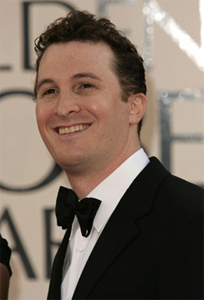
ARONOFSKYS FOUNTAIN OF LOVE.
by Paul Fischer in Los Angeles.For Darren Aronofsky, The Fountain has been a labour of love for several years. This highly complex and original romantic drama explores the fountain of youth, the power and intensity of love, and the nature of obsession. Originally set to star Brad Pitt and Cate Blanchett, the film stars Hugh Jackman as three period incarnations of a character in love with Rachel Weisz, in the middle ages, present day and future. Its been five years since the director last spoke to the media. He spoke to Paul Fischer.
Paul Fischer: Can you talk about the process of finally getting this made, and how frustrating it has been for you?
Darren Aronofsky: It was a very long process, and I think all of my projects have been really challenging. No one really wanted to make a black and white movie about God and math. And then, after Pi, everyone was like, "What do you want to do? What do you want to do next?," and I sent them a copy of Requiem for a Dream, and they was just silence, and barely anyone called me back. For some reason, we just chose films that we think are interesting and cool, and theyre just a little bit outside the box, so its always a big challenge. Brad [Pitt] got really interested at the beginning, and that gave it a lot of fuel. I always wanted a big movie star for it because I knew, when I started this film, I was really inspired by science fiction novels and graphic novels, in the sense that youll be reading a science fiction novel and, for the first 100 pages, you really dont know what the hells going on, and then, suddenly, a few words show up and all these clues, and the world opens up and youre smack in the middle of Neal Stephensons world and it suddenly all makes sense. I wanted to give that similar experience with The Fountain, so the first 20 minutes of the film, youre afloat, and then, suddenly, you meet Rachel and the world starts to come together, and you realize that all those scenes actually do mean something and it does add up to something. My hope was that, by putting a movie star into it, it could hook the audience and help them get through that 20 minutes. So, when Brad expressed interest, it was great. It started it all going. And then, we got really close, and then there was the much publicized shaving of the beard, and then it basically fell apart. There was $18 million against it and a lot of spilled blood. There was really no chance that anything would ever happen. I tried really hard to clean my palette and start something new. All the stuff we actually started new is probably what were going to do next, so that time didnt go to waste. But then, one night, I just couldnt get it out of my system and I just started to write again. Not having to write for a studio or for an actor freed me up to return to what was really important.
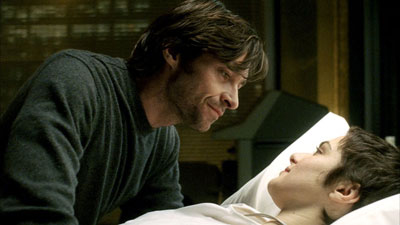 Paul Fischer: Did you trade that beard look that Brad had for the film for the shaved head?
Paul Fischer: Did you trade that beard look that Brad had for the film for the shaved head?Darren Aronofsky: That look is in the film. He was growing the beard for the Conquistador sequences. It took a long time to get to set. I dont know how much longer it was than Hughs beard in the battle scene. I think it was probably pretty similar. Hugh had a big thing. Brad had a big issue about prosthetic beards. He wanted to grow it.
Paul Fischer: Every element of every timeline is in every other timeline. Its a very fractal picture. Everything is related. How did you build that in? Did that come in the script stage? Did you edit that in as you were shooting?
Darren Aronofsky: Its all pre-planned. With the budget that we had, which was extremely low, and the limited amount of time, which was extremely short, to do something like this, it was all about homework. So, all those connections were made beforehand. Of course, things came up where we realized, "Hey, we could stick that here." Things happened on set, but Id say 95% of all decisions are beforehand. When you get to set, no matter how much two-dimensional work you do -- meaning storyboards, shot lists, script work -- as soon as you get into a three-dimensional space with real live actors and real physical equipment, nothing ever works out, so you have to be able to adapt. But, having done all that homework allows you to know what you absolutely need, so you can get pretty close to getting everything you want. But, all the shots were pre-planned. All the star fields that are going on throughout the film -- in space, of course, and then the candles all hanging down, once you throw them out of focus, theyre a star field, the Christmas lights behind Rachel on the rooftop are star fields. We worked with darkness and light in the same way, where Hughs character is in the black and Rachels character is in the light. Hughs never really fully lit until the end of the film, and Rachels lit all the time. That was always planned, 10 months before we ever got to set.
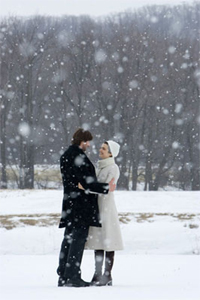 Paul Fischer: Was it Hugh that actually suggested Rachel for this?
Paul Fischer: Was it Hugh that actually suggested Rachel for this?Darren Aronofsky: Yeah. I wasnt into the idea because I had a personal relationship with Rachel and its a gamble. Either the relationship was going to be over or the relationship would be fine, so why risk something like that. Hugh suggested the idea. I wasnt open to it. He said, "Well, lets at least meet." And so, we had dinner at a vegan restaurant. Actually, it wasnt vegan, it was macrobiotic, but I dont know the difference. And, they just completely connected and it was electric. It was one of those things, as a director, you hope happens in a casting room, which rarely ever happens, where you see two actors look at each other and understand each other. And, the thing about Hugh and Rachel was that they were both extremely hungry actors, at the time. Now, theyre big time movie stars. Now, I dont know about working with them. Theyre stage actors and theyre incredibly well trained, and they both hadnt had the opportunity to really show what they could do. That, to me, is the most exciting. Ellen Burstyn has done great stuff, but it had been a long time. Jennifer Connelly and Marlon Wayans had a reason to show up.
Paul Fischer: Did directing Rachel exceed your expectations?
Darren Aronofsky: Shes amazing. I describe her as a cauldron of emotions. You just turn up the heat and things start boiling over. Shes one of those actors that you can get four or five different emotions from, in one choice. To me, thats amazing. When she talks about Moses Morales -- the guy who was buried, and grew up into the tree -- thats one take. Very, very few actors out there can hold an extreme close-up for 40 seconds. Originally, I cut it up like crazy. The first time we cut the film together, it was in pieces. I took the best from here and the best from there, and it worked, but then, I said, "We should go through the material once again," and then we stumbled on that piece, which just worked all the way through. Youve got to let an actor shine when they do something like that.
Paul Fischer: What was changed from The Last Man to The Fountain 1.0' to The Fountain 2.0'?
Darren Aronofsky: The Last Man was always The Fountain 1.0. That was just a secret title. Im a pretty paranoid guy, so we just called it The Last Man. It was always called The Fountain. That was just a false title. Somehow the script got out there and it got leaked, and it became The Last Man, but it was never The Last Man. It was, actually, a working title for us, at the very beginning. One of the big inspirations for the film was this short story about a prisoner who was in this brand new prison in a town in Latin America, and there was a volcano and everyone in the town was wiped out except for the guy who survived in the new prison cell. There was something about immortality and being alone that captured what we were going for. Thats basically what morphed into what we made, which is interesting how a little seed of an idea can become something else. So, The Fountain 1.0' is available. You can see it in the graphic novel, out in hardcover and soft cover by DC Vertigo, available now. Its very, very similar. Theres a few differences. There was a huge battle scene at the beginning of The Fountain 1.0, but it was in a post-Gladiator, pre-Peter Jackson landscape. I was very excited by what Ridley [Scott] had done in Gladiator. I was like, "Wow, this is exciting. We could make a really exciting battle scene." But then, I went through my trials and tribulations, and The Lord of the Rings came out, and I was like, "Well, our Mayan Conquistador battle will never go to that level of fantasy and extremity, so why even do it." And then, of course, Troy came out and King Arthur. All these huge battle scenes had happened. Hollywood had done it. I realized that audiences were yawning when they saw it, so I was like, "This scene is written for Izzi by Tommy. Whats the story?" The story is one man overcoming incredible odds, so it very, very much got down to, eventually, Hugh Jackman against the Mayan army, and thats all I really needed. The simplicity of that liberated me cause then I suddenly realized I didnt need $20 million to shoot it. I could do it for a lot less. That was a budget thing.
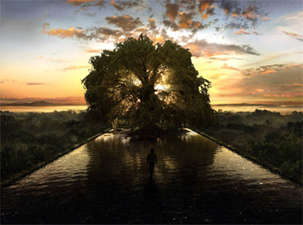 Paul Fischer: Had you seen Hugh Jackman in something that led you to believe he could do such an emotional role?
Paul Fischer: Had you seen Hugh Jackman in something that led you to believe he could do such an emotional role?Darren Aronofsky: How many male actors have you actually seen do emotional work like that? Ive been in 15 cities in the last two or three weeks, and a lot of women have said to me, "Ive never seen a man that vulnerable, on or off screen." I didnt really know what he could do. When I first started this, he wasnt on my list because he had just done Wolverine, which he was fantastic as and became a star off of, which is an amazing, difficult thing to do, if youre a fan. Just to step into that role, out of nowhere, and actually pull it off was a big accomplishment. But, I had seen nothing else. Then, when I saw The Boy From Oz, I just saw an incredible amount of talent. It was undeniable. Outside of what he did in The Fountain, the guy can sing and dance. [Laughs] Its really kind of upsetting. Its just remarkable, what he did in this movie, and its overlooked somewhat. I met Hugh randomly at a bar, or something, with some of his friends. We just said hello. And then, we were staying at the same hotel and I was sitting there doing my 20-pound curls, and this guy is moving a machine across the room. He was pulling this thing and the machine was jumping, and I was like, "What the hell? Who is that freak?" And, it was Hugh Jackman, training for X-Men 2, and I went over and said, "Hey, how are you doin?" Then, Hugh went from that type of size to, in 12 months, being able to get into full Lotus position. Ive been doing yoga for seven or eight years and I cant get into Lotus position. But, he got into full Lotus and performed all those scenes, where hes in Lotus, underwater to make himself float, attached to a barbecue rig, so that when he flips over and goes upside down, the rig basically spun him around, held him upside down for 10 seconds, and then brought him back up, where he would land, for that big revealing shot of the bubble. That was one of the shots he did underwater, and in character. Physically, you wont find a specimen on the planet like him. This is the type of guy that could have been an Olympic gold medal athlete in so many different sports. So, that was amazing. We had a stunt double -- and I know its kind of cliché that he did all of his stunts -- but he was better than the stunt double, in everything. So, thats him climbing the tree, doing the fights, everything. Outside of that, emotionally, he just unleashed. The traditional way to shoot a scene is to start off wide because it establishes the lighting, and then you go in for close-ups. We got the camera and, suddenly, these faucets started to open and we were like, "Okay, cut! Get the camera in as quick as you can!" We flew the camera in and we just went, and he would go until he was dry. And then, we would take a 10-minute break and we would go again until he was dry. It was a bit abusive, but he loved it. [Laughs] We enjoyed it. That was why the editing took so long. He and Rachel, both, played every scene on every note imaginable. Usually, the actor will give you just one kind of take on it, but then I was like, "You know what? Play it as Tomas, play it as Tom, play it sad, play it angry, play it a little angrier, play it really happy." We just bounced around and tried different things, and it was a joy.
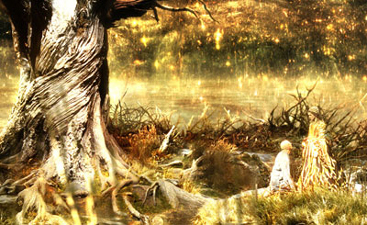 Paul Fischer: So far, all three of your films have been somewhat open to interpretation. At one point, you were attached to do a Batman . .
Paul Fischer: So far, all three of your films have been somewhat open to interpretation. At one point, you were attached to do a Batman . ..Darren Aronofsky: I wasnt ever attached to do Batman. Batman was a writing gig. It was about coming off of Requiem for a Dream, dreaming about doing The Fountain, realizing that was going to cost a decent amount of dime and, seeing how the studio probably perceived me as the guy who just did a $4 million drug movie, when they offered me the chance to do something on Batman and I realized that I could work with one of my heroes, Frank Miller, I was like, "If I develop this, it might actually open up their perception of me to do The Fountain." But, I was really trying to make The Fountain for the last six years.
Paul Fischer: Would you do something more linear like that, or will you continue to have this sort of vision for your films?
Darren Aronofsky: Im just going to make them weirder and weirder and weirder. Weve always been trying to push the envelope of what you can do in cinema. Matty, my DP, always says were Wild Style filmmakers. Wild Style was that crazy, graffiti writing style, but you could recognize who wrote what all the time, by the style of the letters. And, I think were always trying to put a visual language into a film that helps tell the story that youre doing, but is incredibly unique and, hopefully, interesting for people.
Paul Fischer: When The Fountain was put on hold, you said you worked on other things that formed the germ of what will probably be your next project. Can you talk about what that is?
Darren Aronofsky: No. [Laughs]
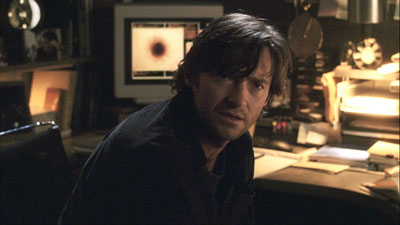 Paul Fischer: You said that your next film was going to be something Biblical, your first film was about God and math, and this film is spiritual, in an agnostic way. Whats your take on God? Are you religious? Do you believe in God?
Paul Fischer: You said that your next film was going to be something Biblical, your first film was about God and math, and this film is spiritual, in an agnostic way. Whats your take on God? Are you religious? Do you believe in God?Darren Aronofsky: I think the themes of The Fountain, about this endless cycle of energy and matter, tracing back to the Big Bang . . . The Big Bang happened, and all this star matter turned into stars, and stars turned into planets, and planets turned into life. Were all just borrowing this matter and energy for a little bit, while were here, until it goes back into everything else, and that connects us all. The cynics out there laugh at this crap, but its true. [Laughs] The messed up thing is how distracted we are and disconnected from that connection, and the result of it is what were doing to this planet and to ourselves. Were just completely killing each other and killing the planet, and its a state of emergency right now, I think. All of my charity work has always been about the environment. There are 15,000 species on the endangered species list. Mercury poisoning is my new thing. [Laughs] Were doing it to ourselves. The fact that theres mercury poisoning in the breast milk of indigenous people in the North Arctic is all coming from us, and Alzheimers is on the rise. What are we doing to ourselves? Its a complete disconnect. To me, thats where the spirituality is. Whatever you want to call that connection -- some people would use that term God. That, to me, is what I think is holy.
Paul Fischer: Did you change anything for the PG-13?
Darren Aronofsky: Theres an added line that was in the trailer, but wasnt in the movie, which is the "Death is a disease and theres a cure, and I will find it." That was a line that Hugh wanted in, that I couldnt figure out a place for, and I had to tinker with it.
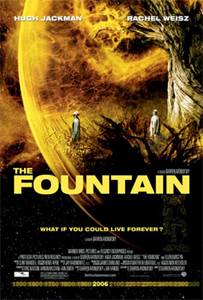 Paul Fischer: You didnt cut any of the violence?
Paul Fischer: You didnt cut any of the violence?Darren Aronofsky: No, no. The violence is all the same.
Paul Fischer: Then how did you change it from R to PG-13?
Darren Aronofsky: Negotiation.
MORE
- Viggo Mortensen The Road
- 24 Cast Reunion
- Aaron Eckhardt No Reservations
- Aaron Eckhart The Dark Knight
- Adam McKay Step Brothers Interview
- Alan Alda Diminished Capacity Interview
- Alan Alda Diminished Capacity Interview
- Alex Dimitriades
- Al Pacino Oceans 13
- Alan Rickman Snow Cake
- Alan Rickman Sweeney Todd



